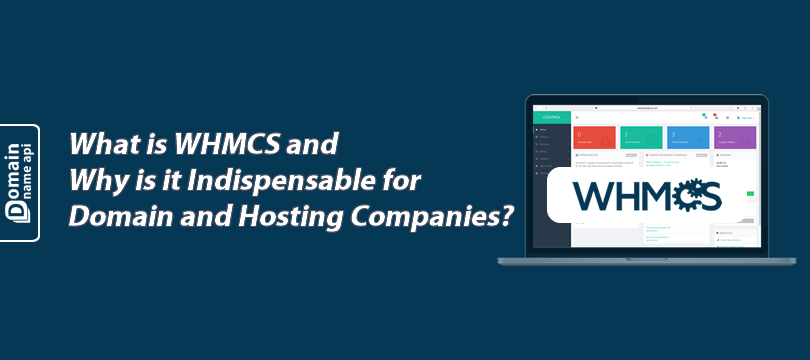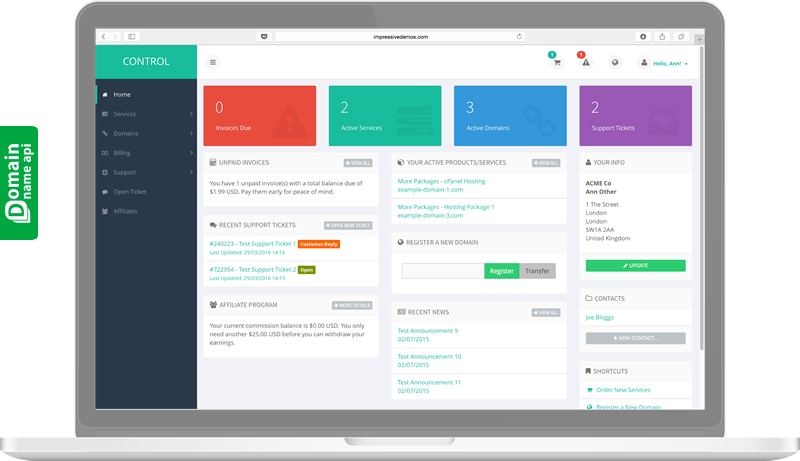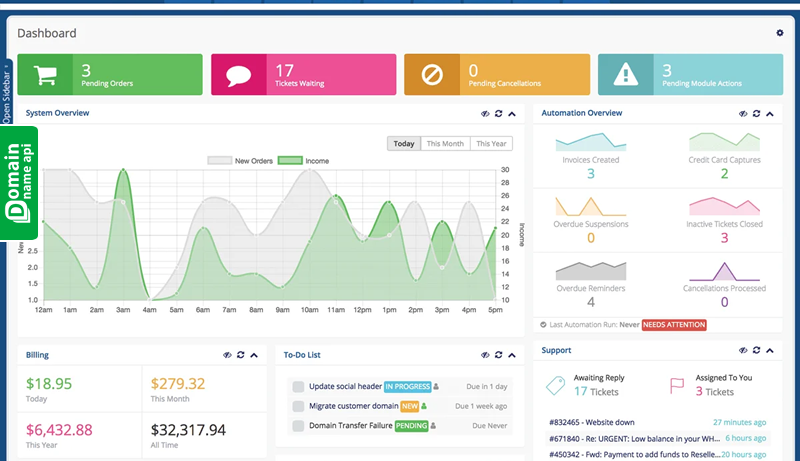
What is WHMCS and Why is it Indispensable for Domain and Hosting Companies?
In today’s ever-evolving digital economy, the ways businesses sustain and expand their online presence are becoming increasingly complex. Companies that offer web hosting, domain registration, SSL certificates, virtual private servers (VPS), dedicated servers, and various other digital services face a unique operational burden. Managing numerous tasks manually — from customer acquisition and recurring billing to technical support and server automation — is both time-consuming and error-prone. This is where WHMCS (Web Host Manager Complete Solution), the industry-leading automation and management solution, becomes a lifeline for digital service providers.
To define WHMCS as merely a billing system would be to overlook its extensive and integrated capabilities. WHMCS is an all-in-one automation and management platform that consolidates, automates, and manages all front-end and back-end operations of a digital service provider under one roof. This platform enables a business to seamlessly manage every stage of the customer lifecycle — from the initial order and payment collection to service activation and support requests. As a result, businesses minimize manual intervention, maximize operational efficiency, and ensure lasting customer satisfaction.
The Origin and Evolution of WHMCS: A Response to Digitalizing Needs
WHMCS was originally developed as a solution to the operational challenges faced by web hosting companies. With the rapid growth of the web hosting market, managing thousands of clients, hundreds of servers, and countless services manually became impossible. Repetitive tasks like billing, service provisioning, suspension, or termination created a massive workload. The primary goal of WHMCS was to automate these tedious and time-consuming tasks, allowing businesses to focus their valuable time and resources on strategic areas such as product development, customer relations, and growth.
Over the years, WHMCS has evolved far beyond being just a hosting billing tool. Thanks to its modular architecture and extensive integration capabilities, it has become indispensable for domain registrars, SSL certificate resellers, VPN providers, software license vendors, and even cloud-based service providers. With ongoing updates and new features introduced by developers, WHMCS has solidified its position as one of the most comprehensive and reliable solutions in the industry. Its purpose is to enhance business efficiency, reduce human error, and help companies gain a competitive edge in the global market.

Core Components of WHMCS: How the System Works
The robust structure of WHMCS is built on a well-designed architecture. This design brings together different functional areas to deliver a seamless experience for both users and administrators.
1. Client Area
This is the front-end interface where WHMCS directly interacts with customers. It serves as a personalized portal for each customer. The Client Area features a user-friendly interface that enables customers to easily manage their services. Through this area, clients can:
- Service Management: View and manage their purchased hosting packages, servers, domain names, or other services; change passwords; or directly access related control panels (e.g., cPanel, Plesk).
- Financial Transactions: View outstanding invoices, make payments, and access past invoices and payment history. They can update credit card details or manage auto-pay settings.
- Support Requests: Open new support tickets, track the status of existing requests, and communicate with the support team.
- Domain Management: Manage DNS records of their domains, check renewal dates, initiate transfers, and update nameservers.
- Personal Information Updates: Update contact information, addresses, and other personal details.
The client panel increases self-service capabilities and reduces the workload on support teams, giving customers more control.
Core Components of WHMCS: How the System Works
The robust structure of WHMCS is built on a well-thought-out architecture. This architecture brings together various functional areas to provide a seamless experience for both users and administrators.
1. Client Area
This is the front-end interface where WHMCS directly interacts with customers. It acts as a personalized portal for each client. The Client Area features a user-friendly interface that allows customers to easily manage their services. Through this area, customers can:
- Service Management: View and manage purchased hosting packages, servers, domain names, or other services; change passwords; or directly access related control panels (such as cPanel, Plesk).
- Financial Transactions: View outstanding invoices, make payments, and access invoice and payment history. They can update credit card information or manage auto-payment settings.
- Support Requests: Create new support tickets, track the status of existing requests, and communicate with the support team.
- Domain Management: Manage DNS records of their domain names, check renewal dates, and perform actions like transfer or nameserver updates.
- Personal Information Updates: Update contact information, addresses, and other personal data.
The client panel increases the self-service rate of the business, reduces the workload of the support team, and gives customers more control.
2. Admin Dashboard
This is the central control panel designed for business owners and staff to manage all operational processes. All administrative, financial, technical, and support-related tasks are handled here. The Admin Area is protected with strong security measures (two-factor authentication, IP restrictions, etc.). Key operations that can be performed in the admin panel include:
- Customer Management: Create, edit, suspend, or delete customer accounts. Full access to customer information, billing history, service details, and support requests.
- Product and Service Configuration: Define new product and service packages, set pricing and feature settings, and integrate automatic provisioning modules.
- Billing and Finance: Generate invoices, accept payments, process refunds, track accounting records, and generate detailed financial reports.
- Support Management: Respond to incoming support requests, assign tickets to departments, update statuses, and manage the knowledge base.
- Server Management: Configure integrated servers, monitor server statuses, and manage automation through server modules.
- System Settings: Manage general system settings, email templates, security configurations, language options, and all other system configurations.
3. API (Application Programming Interface)
A powerful tool that enables WHMCS to integrate seamlessly with third-party applications, custom software, or other systems. Through the API, core WHMCS functions can be accessed programmatically by external systems. For example, creating a client via custom CRM software, sending orders through a sales app, or accessing WHMCS data via a custom reporting tool — all can be achieved using the API. This provides businesses with more automation and customization capabilities.
4. Database
All customer information, product and service details, invoices, payment records, support requests, and system settings are stored in a relational database, typically MySQL. This central database ensures all WHMCS components access consistent and up-to-date information. It is critically important for security and backup purposes.
Comprehensive Features of WHMCS: Digital Service Management

The industry-leading position of WHMCS is ensured by its wide and integrated feature set. Each feature addresses a specific challenge faced by digital service providers and significantly streamlines workflows.
Strategic Advantages of Using WHMCS for Businesses

The features offered by WHMCS not only simplify operations but also provide strategic benefits that give businesses a competitive edge:
- Revolution in Operational Efficiency: Automating manual tasks significantly reduces the time your staff spends on repetitive work. This allows teams to focus on more complex issues, develop new products, or strengthen customer relations — leading to direct cost savings and higher productivity.
- Increased Customer Satisfaction and Loyalty: Fast and automated service activation, convenient payment options, 24/7 accessible client area, and prompt support responses create a smooth experience for customers. Satisfied customers not only make more purchases but also help spread positive word-of-mouth about your brand.
- Scalability and Growth Support: As your business grows, WHMCS’s modular structure and automation capabilities make it easy to manage increasing customer numbers and service volumes. Instead of hiring more staff, you can use your existing infrastructure more efficiently to scale operations.
- Optimized Revenue Streams: Automated billing and overdue payment reminders increase collection rates and improve cash flow. WHMCS also provides tools to manage cross-selling and upselling opportunities.
- Reduced Risk of Human Error: Automated processes eliminate errors caused by manual data entry or human involvement. This reduces service disruptions and customer complaints.
- Real-Time Business Intelligence: Comprehensive reporting and analytics tools provide business owners and managers with real-time, accurate insights into financial status, customer behavior, and operational performance. These insights support more informed decision-making and strategic planning.
- Compliance with Industry Standards and Reliability: WHMCS is a widely adopted and tested solution in the web hosting and digital services industry. With continuous updates and security patches, businesses can be confident that their systems remain up-to-date and secure.
Strategic Advantages of Using WHMCS for Businesses

The features offered by WHMCS not only simplify operations but also provide strategic benefits that give businesses a competitive edge:
- Revolution in Operational Efficiency: Automating manual tasks significantly reduces the time your staff spends on repetitive work. This allows teams to focus on more complex issues, develop new products, or strengthen customer relations — leading to direct cost savings and higher productivity.
- Increased Customer Satisfaction and Loyalty: Fast and automated service activation, convenient payment options, 24/7 accessible client area, and prompt support responses create a smooth experience for customers. Satisfied customers not only make more purchases but also help spread positive word-of-mouth about your brand.
- Scalability and Growth Support: As your business grows, WHMCS’s modular structure and automation capabilities make it easy to manage increasing customer numbers and service volumes. Instead of hiring more staff, you can use your existing infrastructure more efficiently to scale operations.
- Optimized Revenue Streams: Automated billing and overdue payment reminders increase collection rates and improve cash flow. WHMCS also provides tools to manage cross-selling and upselling opportunities.
- Reduced Risk of Human Error: Automated processes eliminate errors caused by manual data entry or human involvement. This reduces service disruptions and customer complaints.
- Real-Time Business Intelligence: Comprehensive reporting and analytics tools provide business owners and managers with real-time, accurate insights into financial status, customer behavior, and operational performance. These insights support more informed decision-making and strategic planning.
- Compliance with Industry Standards and Reliability: WHMCS is a widely adopted and tested solution in the web hosting and digital services industry. With continuous updates and security patches, businesses can be confident that their systems remain up-to-date and secure.

